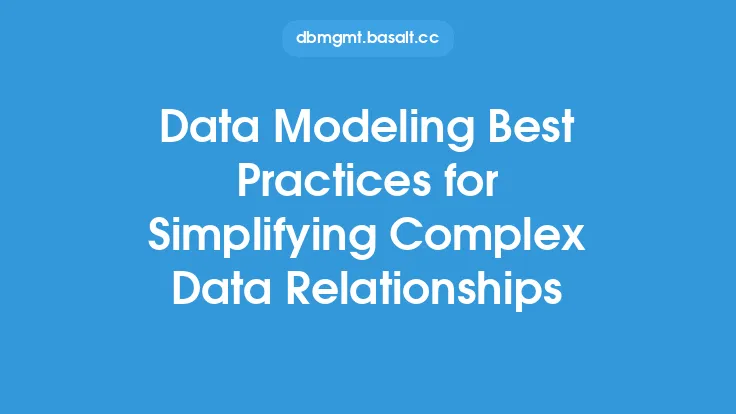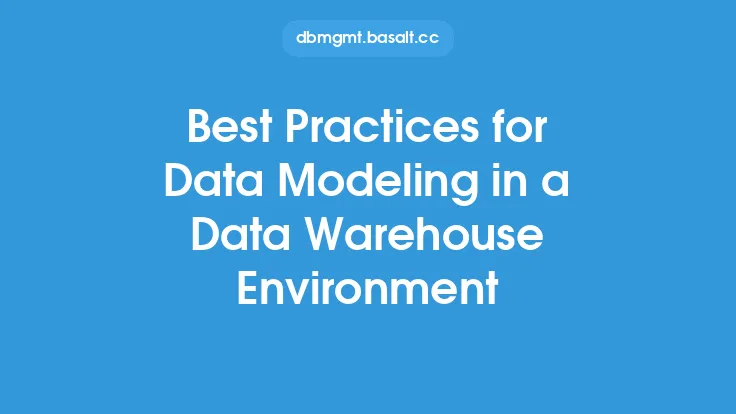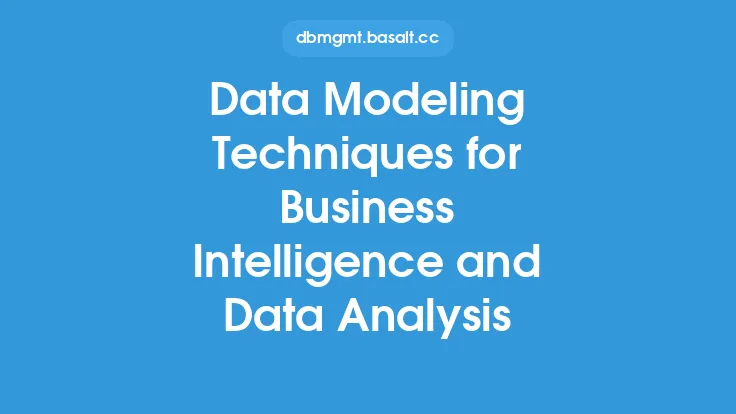When it comes to business intelligence initiatives, data modeling plays a crucial role in ensuring the success of the project. A well-designed data model is essential for creating a robust and scalable business intelligence system that can provide valuable insights and support informed decision-making. In this article, we will discuss the best practices for data modeling in business intelligence initiatives, highlighting the key principles, techniques, and considerations that can help organizations create effective data models.
Introduction to Data Modeling
Data modeling is the process of creating a conceptual representation of the data used in a business intelligence system. It involves identifying the key entities, attributes, and relationships that are relevant to the business, and organizing them into a logical and consistent structure. A good data model should be able to capture the complexity of the business, while also being simple enough to understand and maintain. There are several types of data models, including entity-relationship models, dimensional models, and object-oriented models, each with its own strengths and weaknesses.
Key Principles of Data Modeling
There are several key principles that should guide the data modeling process. First, the data model should be driven by the business requirements, rather than by the technology or tools used to implement it. This means that the data model should be designed to meet the needs of the business users, rather than the needs of the IT department. Second, the data model should be simple and intuitive, avoiding unnecessary complexity and ensuring that the data is easy to understand and navigate. Third, the data model should be flexible and adaptable, able to evolve and change as the business needs change. Finally, the data model should be well-documented and maintained, with clear and concise definitions of the entities, attributes, and relationships.
Data Modeling Techniques
There are several data modeling techniques that can be used to create a robust and effective data model. One of the most popular techniques is entity-relationship modeling, which involves identifying the key entities and relationships in the business, and organizing them into a logical and consistent structure. Another technique is dimensional modeling, which involves organizing the data into a series of related dimensions, such as customer, product, and time. Object-oriented modeling is also a popular technique, which involves modeling the data as a series of objects and classes, with inheritance and polymorphism.
Data Modeling for Business Intelligence
When it comes to business intelligence, data modeling plays a critical role in ensuring the success of the project. A well-designed data model is essential for creating a robust and scalable business intelligence system that can provide valuable insights and support informed decision-making. The data model should be designed to support the key business processes and functions, such as reporting, analysis, and data mining. The data model should also be designed to integrate with other systems and tools, such as data warehouses, data marts, and business intelligence platforms.
Data Warehouse Design
A data warehouse is a centralized repository that stores data from various sources, and is designed to support business intelligence and data analysis. When designing a data warehouse, it is essential to consider the data modeling principles and techniques discussed earlier. The data warehouse should be designed to support the key business processes and functions, such as reporting, analysis, and data mining. The data warehouse should also be designed to integrate with other systems and tools, such as business intelligence platforms and data marts.
Data Mart Design
A data mart is a subset of the data warehouse, and is designed to support a specific business function or process. When designing a data mart, it is essential to consider the data modeling principles and techniques discussed earlier. The data mart should be designed to support the key business processes and functions, such as reporting, analysis, and data mining. The data mart should also be designed to integrate with other systems and tools, such as business intelligence platforms and data warehouses.
Data Governance
Data governance is the process of managing and controlling the data assets of an organization. When it comes to data modeling, data governance plays a critical role in ensuring the quality, integrity, and security of the data. The data governance process should include data modeling, data quality, data security, and data compliance. The data governance process should also include data stewardship, which involves assigning responsibility for the data to specific individuals or teams.
Data Quality
Data quality is a critical aspect of data modeling, and involves ensuring that the data is accurate, complete, and consistent. When designing a data model, it is essential to consider the data quality principles and techniques, such as data validation, data cleansing, and data normalization. The data quality process should also include data profiling, which involves analyzing the data to identify patterns, trends, and anomalies.
Best Practices for Data Modeling
There are several best practices that can be followed to ensure the success of a data modeling project. First, the data modeling process should be driven by the business requirements, rather than by the technology or tools used to implement it. Second, the data model should be simple and intuitive, avoiding unnecessary complexity and ensuring that the data is easy to understand and navigate. Third, the data model should be flexible and adaptable, able to evolve and change as the business needs change. Finally, the data model should be well-documented and maintained, with clear and concise definitions of the entities, attributes, and relationships.
Conclusion
In conclusion, data modeling is a critical aspect of business intelligence initiatives, and involves creating a conceptual representation of the data used in the system. By following the key principles, techniques, and best practices discussed in this article, organizations can create effective data models that support their business intelligence initiatives and provide valuable insights and support informed decision-making. Whether you are designing a data warehouse, data mart, or business intelligence platform, a well-designed data model is essential for ensuring the success of the project. By investing in data modeling, organizations can improve the quality and integrity of their data, and make better decisions to drive their business forward.





